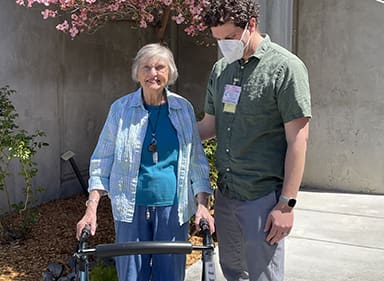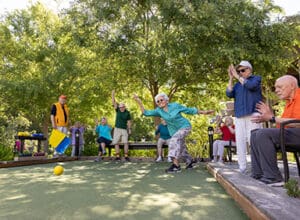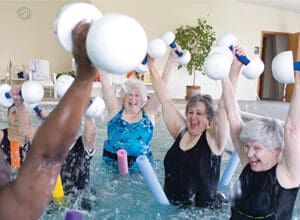Here at Spring Lake Village senior living community, some of our residents use walkers to help them stay mobile and safe. They are an excellent device for doing so. To some, starting to use a walker may feel like you are not able to do as much, but in reality, it is quite the opposite.
Whether you have chronic pain, fatigue, balance problems, vision loss, stroke, or anything else that may limit your mobility, physical therapists and other medical professionals recommend walkers to help you to stay independent, active, safe and engaged at Spring Lake Village or anywhere, for as long as possible.
However, it is crucial to make sure that you are using your walker safely to prevent falls and injuries; here are a few tips to help:

- Make sure the walker handles are adjusted to your correct height; level with your hips is typically a good height, making sure that your elbows have a slight bend. Another way to evaluate whether your walker is at the correct height is to stand up as straight as you can and place the walker right in front of you. Is the top of the walker at the height of your wrist? If not, it needs to be adjusted.
- Make sure that your walker does not get too far away from you, as this increases the risk of falling. When you are walking, keep your elbows close to your body and try to walk so that you are stepping forward to be in line with the walker legs that are closest to you. Be sure that the walker is not so close that you cannot take a normal step forward, but not so far away that you are reaching. When reaching for something, get as close as you can with the walker before reaching.
- All four legs or wheels should be touching the ground before moving.
- Be aware of your surroundings. In your home, make sure that pathways always remain clear of clutter. Always look forward, not down, to scan for potential hazards as you are walking. Do not use the walker to pull yourself up to stand. Push up from where you are sitting. Once you’ve pushed yourself up as high as you can, then reach for the walker to stand fully upright.
- If you have a four-wheeled walker, make sure the brakes are in good working order, and always lock the brakes before sitting down on the seat of your walker. When possible, push the walker up against a wall before sitting down. Do not move around while sitting on the walker. Keep the brakes locked until you are ready to resume walking.
Having a fear of falling is a good reason to institute the use of an assistive device. Fear of falling can lead to a self-imposed restriction in activities, which leads to a decreased quality of life, loss of independence, and increased dependency. The decrease in activity also begins a cycle in which being less active results in joint stiffness, muscle weakness, and reduced physical conditioning — which, in turn, increases the likelihood of falls.
Using a walker is a great way to ensure that you are able to keep participating in whatever you enjoy. Make sure that you are safe and mindful when using a walker to help prevent falls.
At Spring Lake Village, our entire staff is dedicated to helping our residents live their best lives. Our residents have access to our therapy team, and the fitness center and its experts.
By Aaron Calderon, OTD, OTR/L
Rehabilitation Director
Spring Lake Village







